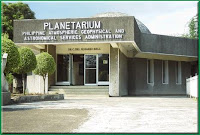 |
| with my Astromates observing at an Urban location |
There are some periods & locations in urban sites where you can observe depending on the sky quality at a given time. Dr. Jesus Rodrigo Torres, professor of astronomy at RTU and member of the IAU, designed an urban astronomy scale (being used by NASA) for which you can categorize the night sky.
He categorized the sky conditions as follows:
I. Best sky quality with the lights from the residential and commercial centers subdued; the air is satisfactorily transparent; a hint of the Milky Way can be glimpsed in the Scorpius-Sagittarius region; moonless and cloudless.
II. Good sky quality with the air being satisfactorily transparent, but lights in commercial and residential areas still on; moonless and cloudless.
III. Moderately poor sky quality with high or fast-moving clouds revealing patches of transparent sky, but light in commercial and residential centers is subdued; Moon in crescent phase.
IV. Poor sky quality with high or fast-moving clouds; lights in commercial and residential centers are still on; Moon in crescent phase.
V. Bad sky quality with haze; lights in commercial and residential centers still on; limiting magnitude is +3.0; Moon in quarter phase.
VI. Very bad sky quality with haze or clouds almost covering the entire sky; heavy air and light pollution; Moon first quarter or bigger; limiting magnitude ranging from +2 and +3.
Under each category there are still a number of things you can observe. For a category VI, you can still observe the moon, planets and bright single or double stars.
We were just observing last night till dawn under category IV-V skies. We were able to observe Jupiter, the Orion Nebula, Pleiades, Draco, Sirius and also the thin waning crescent moon (28 day old moon). We observed using a Travel Scope 70, and a 10x50 UpClose binoculars.
 | |
| Thin Waning Crescent Moon. Photo Taken via afocal method with a Travel Scope 70 (10mm eyepiece) and Sony DSC-W350.Photo by Lieza Crisostomo. |













